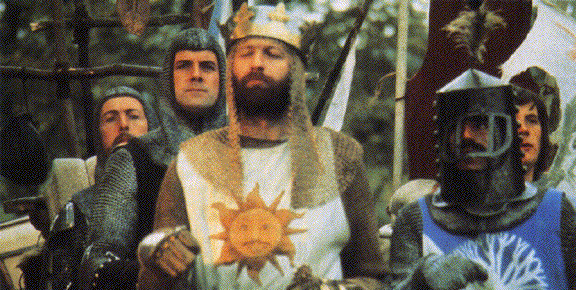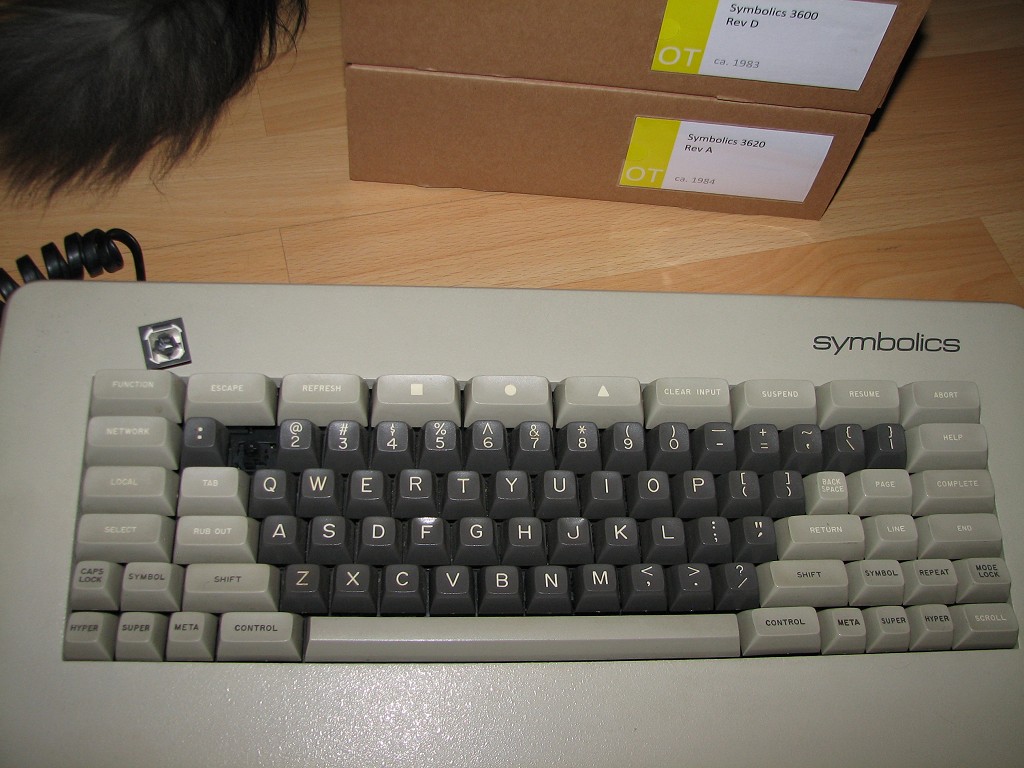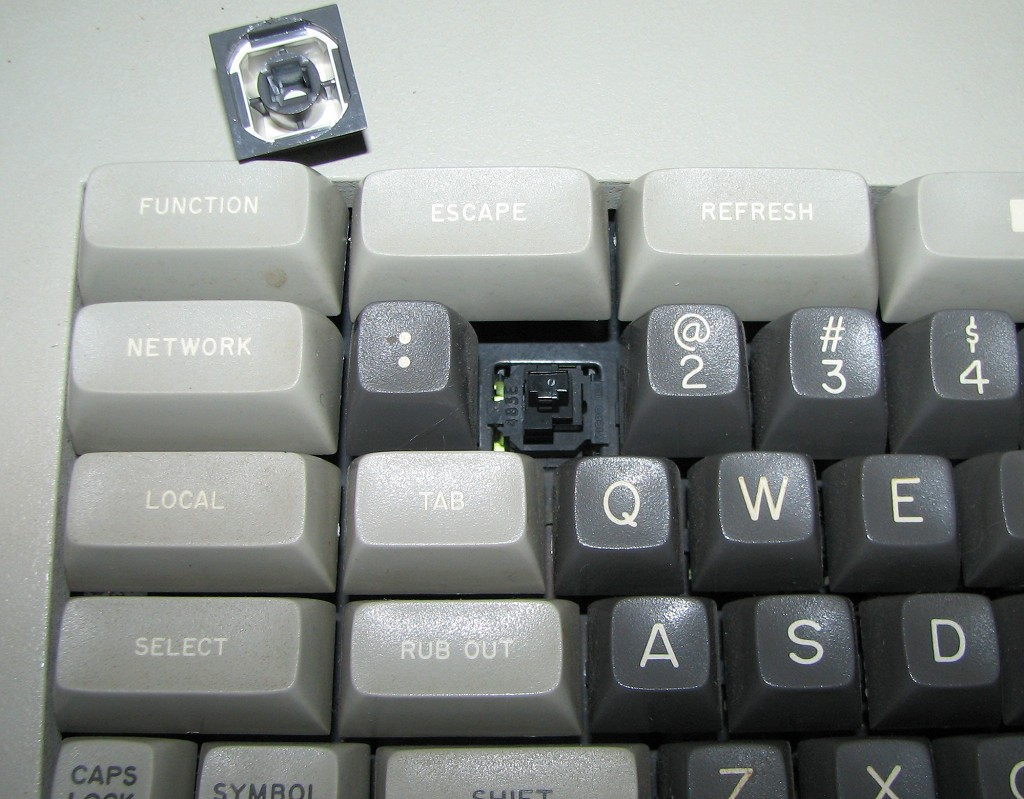Code: Select all
;;; -*- Mode: Lisp; Base: 8; Package: User -*-
(defun complement (x)
(logxor 377 x))
(setq bitmap 60) ;60-77 Bit map. 0 if key up, 1 if key down.
;To read from keyboard, P1<4:1> gets column number, then P1<0> gets 0,
;then read back keys from P2, then P1<1> gets 1 again.
;P1<7> = pin 5 on the connector
;P1<6> = pin 3 on the connector (used for data)
;P1<5> = pin 1 on the connector
;T1 = pin 2 on the connector (used for clock)
;The following are the bit numbers of the keys which are specially
;known about for shifting purposes:
; mode lock 3
; caps lock 125
; alt lock 15
; repeat 115
; top 104 / 155
; greek 44 / 35
; shift 24 / 25
; hyper 145 / 175
; super 5 / 65
; meta 45 / 165
; control 20 / 26
; For booting, we know that rubout is 23 and return is 136
(putprop 'ukbd '(
(= 0)
(jmp beg)
(= 100)
beg (mov a (/# 377))
(outl p1 a) ;Mainly turn off data out
(outl p2 a) ;Enable input
(mov r0 (/# bitmap)) ;Clear the bitmap
(mov r1 (/# 20))
(clr a)
clear-bitmap-loop
(mov @r0 a)
(inc r0)
(djnz r1 clear-bitmap-loop)
;Scanning Loop.
;R2 is bitmap index in bytes, plus 1
;R0,R1 temporary as usual
scan-keyboard
(mov r2 (/# 20))
scan-loop
(mov a (/# (1- bitmap)))
(add a r2) ;Address of bitmap byte
(mov r0 a)
(mov a r2)
(dec a)
(orl p1 (/# 37)) ;P1<4:1> R2-1, and disable decoder
(jb0 scan-loop-p1out-0)
(anl p1 (/# (complement 2_0)))
scan-loop-p1out-0
(jb1 scan-loop-p1out-1)
(anl p1 (/# (complement 2_1)))
scan-loop-p1out-1
(jb2 scan-loop-p1out-2)
(anl p1 (/# (complement 2_2)))
scan-loop-p1out-2
(jb3 scan-loop-p1out-3)
(anl p1 (/# (complement 2_3)))
scan-loop-p1out-3
(anl p1 (/# (complement 1))) ;Strobe the decoder
(in a p2) ;Get row of keys
(xrl a @r0) ;A changed bits
(jnz scan-found) ;Jump if key state changed
(djnz r2 scan-loop)
;
(jmp scan-keyboard)
;R0 address of bit map entry
;R2 bit number
;R3 changed bits
;R4 bit mask
scan-found
(mov r3 a)
(mov r4 (/# 1))
(mov a r2) ;Bit number is byte number times 8
(dec a)
(rl a)
(rl a)
(rl a)
(mov r2 a)
scan-bits-loop
(mov a r4)
(anl a r3)
(jnz scan-found-key)
(inc r2)
(mov a r4) ;Shift left one bit, A 0 when done
(add a r4)
(mov r4 a)
(jnz scan-bits-loop)
(jmp scan-keyboard) ;wtf? should have found something
scan-found-key
(mov a r4) ;Bit mask
(xrl a @r0) ;Change bitmap bit
(mov @r0 a) ;Put back in bitmap
(anl a r4) ;0 if key now up, non-0 if key now down
(mov r3 (/# 0)) ;Assume key down
(jnz scan-found-key-down)
(inc r3) ;Key up, middle byte is 1
;; If this is a shifting key, don't send all-keys-up, send this-key-up.
;; This is so that with paired shifting keys we know which it is.
(mov a r0)
(add a (/# (- 200 bitmap))) ;Point to mask of non-shifting keys
(movp3 a @a)
(anl a r4) ;A gets bit from table (0 => shifting)
(jz scan-found-key-down) ;Shifting => don't send all-keys-up
;; Look through the bit map and see if all non-shifting keys are now
;; up. If so, send an all-keys-up instead.
(mov r0 (/# bitmap))
(mov r1 (/# 200)) ;P3 table at 1600
(mov r4 (/# 20))
check-for-all-up
(mov a r1)
(movp3 a @a)
(anl a @r0)
(jnz scan-found-key-down)
(inc r0)
(inc r1)
(djnz r4 check-for-all-up)
(call compute-all-up-code)
scan-found-key-down
(mov r4 (/# 371)) ;Source ID 1 (new keyboard)
(call send) ;Transmit character
(call check-boot) ;See if request to boot machine
(jmp scan-keyboard)
;Subroutine to transmit like old-type Knight keyboard
;Send a 24-bit character from R2, R3, R4
;T1 = pin 2 on the connector (used for clock)
;P1<6> = pin 3 on the connector (used for data)
;Data output is normally high, we make it low to get the attention of the keyboard
; multiplexor.
;Clock input is normally high, its low-going transition is when we send the next bit.
;A 1 bit is a high.
;R0 has a count
;Timing: (1 cycle = about 4 microseconds)
;Clock-low to data-change: 4 to 6 cycles
;Data-change to await-clock-high: 1 cycle
;Clock-high to await-clock-low: 6 cycles best case, 15 cycles worst case
;Start-bit to await-clock-low: 7 cycles
;If clock is symmetric, minimum period is 22 cycles (88 microseconds).
send (anl p1 (/# (complement 1_6))) ;Send a 0 to start
(mov a r2)
(call send-byte)
(mov a r3)
(call send-byte)
(mov a r4)
(call send-byte)
send-1 (jnt1 send-1) ;Await clock high (idle)
(orl p1 (/# 1_6)) ;Restore line to high
(ret)
send-byte
(mov r0 (/# 10))
send-byte-1
(jb0 send-a-1)
send-a-0
(jt1 send-a-0) ;Await clock low
(anl p1 (/# (complement 1_6))) ;Send a 0
send-next-bit-0
(rrc a)
send-await-clock-high-0
(jnt1 send-await-clock-high-0)
(djnz r0 send-byte-1)
(ret)
send-a-1
(jt1 send-a-1) ;Await clock low
(orl p1 (/# 1_6)) ;Send a 1
send-next-bit-1
(rrc a)
send-await-clock-high-1
(jnt1 send-await-clock-high-1)
(djnz r0 send-byte-1)
(ret)
(= 400)
;Return in R2 and R3 the low 16 bits of an all-up key-code.
;This works by checking through the bitmap looking for shift keys
;that are down, and OR'ing in the bits.
compute-all-up-code
(mov r2 (/# 0))
(mov r3 (/# 200)) ;Start with only bit 15 set
(mov r5 (/# 0)) ;R5 address in P3
(mov r0 (/# bitmap)) ;R0 address in bitmap
cauc-0 (mov r4 (/# 1)) ;R4 bit mask
cauc-1 (mov a r5)
(movp3 a @a) ;Get table entry
(jb7 cauc-9) ;Jump if this key not a shifter
(mov r6 a) ;Save bit number
(mov a r4) ;Check bit in bit map
(anl a @r0)
(jz cauc-9) ;Key not pressed
(mov a r6) ;See if bit number 8 or more
(add a (/# -8))
(jb7 cauc-4) ;Jump if less than 8
(mov r6 a) ;Save bitnumber within middle byte
(call cauc-sh)
(orl a r3)
(mov r3 a)
(jmp cauc-9)
cauc-4 (call cauc-sh)
(orl a r2)
(mov r2 a)
;Done with this key, step to next
cauc-9 (inc r5) ;Advance P3 address
(mov a r4) ;Shift bit mask left 1
(add a r4)
(mov r4 a)
(jnz cauc-1) ;Jump if more bits this word
(inc r0) ;Advance bitmap address
(mov a r0) ;See if done
(add a (/# (- (+ bitmap 20))))
(jnz cauc-0) ;Jump if more words in bitmap
(ret) ;Result is in R2,R3
;Produce in A a bit shifted left by amount in R6
cauc-sh (inc r6) ;Compensate for DJNZ
(mov a (/# 200))
cauc-sh-1
(rl a)
(djnz r6 cauc-sh-1)
(ret)
;Is request to boot machine if both controls and both metas are held
;down, along with rubout or return. We have just sent the key-down codes
;for all of those keys. We now send a boot character, then delay for 3 seconds
;to give the machine time to load microcode and read the character to see whether
;it is a warm or cold boot, before sending any other characters, such as up-codes.
; meta 45 / 165
; control 20 / 26
; rubout 23
; return 136
; The locking keys are in bytes 1, 3, and 12, conveniently out of the way
;A boot code:
; 15-10 1
; 9-6 0
; 5-0 46 (octal) if cold, 62 (octal) if warm.
check-boot
(mov r0 (/# 64)) ;Check one meta key
(mov a @r0)
(xrl a (/# 1_5))
(jnz not-boot)
(mov r0 (/# 76)) ;Check other meta key
(mov a @r0)
(xrl a (/# 1_5))
(jnz not-boot)
(mov r0 (/# 62)) ;Check byte containing controls and rubout
(mov a @r0)
(xrl a (/# (+ 1_0 1_6 1_3)))
(jz cold-boot) ;Both controls and rubout => cold-boot
(xrl a (/# 1_3))
(jnz not-boot)
(mov r0 (/# 73)) ;Check for return
(mov a @r0)
(xrl a (/# 1_6))
(jnz not-boot)
warm-boot
(mov r2 (/# 62))
(jmp send-boot)
cold-boot
(mov r2 (/# 46))
send-boot
(mov r3 (/# 374)) ;1's in bits 15-10
(mov r4 (/# 371)) ;Source ID 1 (new keyboard)
(call send) ;Transmit character
(mov r4 (/# 6)) ;Delay 3 seconds
boot-delay-1
(mov r3 (/# 0)) ;Delay 1/2 second
boot-delay-2
(mov r2 (/# 0)) ;Delay 2 milliseconds
boot-delay-3
(djnz r2 boot-delay-3)
(djnz r3 boot-delay-2)
(djnz r4 boot-delay-1)
not-boot
(ret)
;In P3 (1400-1577) we have a table, indexed by key number, of shifting
;keys. The byte is 200 for ordinary keys, or the bit number in the
;all-keys-up message for locking and shifting keys.
(= 1400)
200 ;0
200
200
9. ;3 mode lock
200
6. ;5 super
200
200
200 ;10
200
200
200
200
8. ;15 alt lock
200
200
4. ;20 control
200
200
200
0. ;24 shift
0. ;25 shift
4. ;26 control
200
200 ;30
200
200
200
200
1. ;35 greek
200
200
200 ;40
200
200
200
1. ;44 greek
5. ;45 meta
200
200
200 ;50
200
200
200
200
200
200
200
200 ;60
200
200
200
200
6. ;65 super
200
200
200 ;70
200
200
200
200
200
200
200
200 ;100
200
200
200
2. ;104 top
200
200
200
200 ;110
200
200
200
200
10. ;115 repeat
200
200
200 ;120
200
200
200
200
3. ;125 caps lock
200
200
200 ;130
200
200
200
200
200
200
200
200 ;140
200
200
200
200
7. ;145 hyper
200
200
200 ;150
200
200
200
200
2. ;155 top
200
200
200 ;160
200
200
200
200
5. ;165 meta
200
200
200 ;170
200
200
200
200
7. ;175 hyper
200
200
(= 1600)
;Locations 1600-1617 contain a mask which has 1's for bit-map positions
;which contain non-shifting keys.
327 ;3 and 5
337 ;15
216 ;20, 24, 25, 26
337 ;35
317 ;44, 45
377
337 ;65
377 ;70
357 ;104
337 ;115
337 ;125
377
337 ;145
337 ;155
337 ;165
337 ;175
)
'code)
;Look at kbd and print out any characters that come in
(defun test ()
(let ((tv-more-processing-global-enable nil))
(do ((ch)) (nil)
(process-allow-schedule)
(and (setq ch (si:kbd-tyi-raw-no-hang))
(print (ldb 0027 ch))))))
;This version isn't stoppable, because it just gets it right out of the hardware
;Prevents you from getting screwed by call-processing and the like.
(defun supertest ()
(let ((tv-more-processing-global-enable nil))
(do ((ch)) (nil)
(or si:kbd-buffer (si:kbd-get-hardware-char-if-any))
(and si:kbd-buffer
(progn (setq ch si:kbd-buffer si:kbd-buffer nil)
(print (ldb 0027 ch)))))))




























